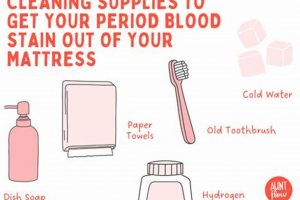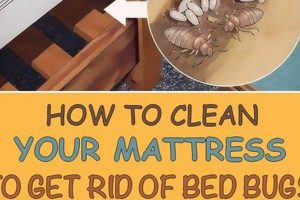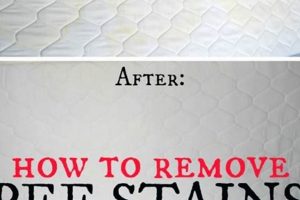The removal of perspiration discolorations from sleep surfaces is a common household challenge. These stains occur due to the body’s natural release of moisture during sleep, which, when absorbed into mattress fibers, can leave unsightly marks and potentially foster bacterial growth.
Addressing such staining is crucial for maintaining a hygienic sleep environment and prolonging the lifespan of the mattress. Untreated sweat accumulation can degrade mattress materials over time and contribute to unpleasant odors. Historically, various cleaning methods have been employed, ranging from simple sun-drying techniques to the application of specialized cleaning agents, each with varying degrees of effectiveness.
The subsequent discussion will detail effective strategies for the successful eradication of these blemishes from mattresses, providing a step-by-step guide to the cleaning process using readily available household supplies and techniques. These methods prioritize both stain removal and the preservation of mattress integrity.
Effective Strategies for Mattress Stain Removal
The following recommendations provide practical guidance for addressing perspiration stains on mattresses, promoting cleanliness and extending the product’s usability.
Tip 1: Employ a vacuum cleaner equipped with an upholstery attachment to thoroughly remove surface-level dust and debris. This preparatory step enhances the efficacy of subsequent cleaning agents.
Tip 2: Prepare a cleaning solution by mixing equal parts of cold water and white vinegar. The mild acidity of vinegar aids in breaking down stain molecules without harsh chemical exposure.
Tip 3: Lightly dampen a clean cloth with the vinegar solution and gently blot the stained area. Avoid saturating the mattress, as excessive moisture can lead to mold growth.
Tip 4: Sprinkle baking soda liberally over the dampened area. Baking soda acts as a natural deodorizer and absorbent, drawing out residual moisture and odors.
Tip 5: Allow the baking soda to sit for several hours, preferably overnight, to maximize its absorbent capabilities.
Tip 6: Vacuum the baking soda completely from the mattress using the upholstery attachment. Ensure no residue remains.
Tip 7: For stubborn stains, consider using a commercial enzyme cleaner specifically designed for upholstery. Always follow the manufacturer’s instructions carefully.
Tip 8: After stain treatment, air out the mattress thoroughly in a well-ventilated area, or use a fan to expedite the drying process.
Adherence to these recommendations facilitates effective stain removal and contributes to a cleaner, healthier sleep environment. Consistent maintenance prolongs the mattress’s lifespan and enhances user comfort.
The succeeding section will address preventive measures to minimize future stain occurrences.
1. Assessment
The initial evaluation of a mattress stain is a critical determinant in the selection of appropriate cleaning methods and the likelihood of successful stain removal. The age, size, and intensity of the discoloration dictate the aggressiveness of the required treatment. For instance, a fresh, minor stain might respond favorably to a simple solution of water and mild detergent, whereas an older, deeply embedded stain may necessitate more potent enzymatic cleaners or professional intervention. Without a proper preliminary assessment, the chosen cleaning method may prove ineffective or, worse, potentially damage the mattress fabric.
Consider the case of a mattress that has accumulated small sweat stains over several months. These stains, initially faint, become increasingly resistant to superficial cleaning attempts. An accurate assessment reveals that the perspiration has penetrated deep into the mattress fibers, requiring a targeted approach. This might involve applying a specialized stain remover directly to the affected areas, allowing sufficient dwell time for the solution to break down the stain molecules before extraction. A misdiagnosis could lead to the use of inappropriate cleaning agents, potentially setting the stain further or causing discoloration of the surrounding fabric.
In conclusion, thorough evaluation of stain characteristics is not merely a preliminary step but an integral component of the stain removal process. Accurate assessment minimizes the risk of ineffective treatment or damage to the mattress, thereby maximizing the chances of successful stain eradication. The failure to conduct an adequate assessment can lead to wasted effort, resource expenditure, and potential compromise of the mattress’s structural integrity.
2. Cleaning Agents
The selection of appropriate cleaning agents is paramount to the effective removal of perspiration stains from mattresses. The efficacy of “how to get sweat stains out of mattress” efforts is directly correlated to the chemical properties of the chosen solution and its interaction with the stain’s composition. Perspiration contains salts, oils, and proteins that bind to mattress fibers, necessitating agents capable of dissolving these components without damaging the underlying material. Inadequate selection can result in stain exacerbation, fabric discoloration, or even structural degradation of the mattress. For instance, using a bleach-based cleaner on a memory foam mattress could compromise its integrity, whereas a mild enzymatic cleaner might effectively break down the protein components of the stain without causing harm.
The practical application of this understanding is evident in the variety of cleaning agents available for specific mattress types and stain severities. White vinegar, a mild acid, is frequently employed to neutralize odors and loosen stain particles. Baking soda, an alkali, acts as an absorbent to draw out moisture and remaining residue. In more severe cases, commercially available enzyme cleaners are utilized to target and break down complex organic compounds. The effectiveness of each cleaning agent relies on its correct application and dwell time, followed by thorough removal to prevent residue buildup. Real-life examples frequently involve individuals experimenting with various cleaning agents until finding one that aligns with the specific stain and mattress composition, underscoring the importance of informed selection.
In summary, the appropriate selection and application of cleaning agents are critical determinants in successful mattress stain removal. The correlation between the agent’s chemical properties and the stain’s composition directly influences the outcome. Challenges remain in identifying the least abrasive yet most effective agent, requiring a balanced approach that considers both stain removal and mattress preservation. This careful consideration underscores the importance of informed decision-making in maintaining a clean and hygienic sleep environment.
3. Application Method
The success of any attempt to eradicate perspiration stains from a mattress hinges significantly on the chosen application method of cleaning agents. Improper application can render even the most potent cleaning solutions ineffective or, conversely, inflict damage on the mattress fibers. The connection between application method and stain removal stems from the necessity to effectively introduce the cleaning agent into the affected area without oversaturation, which can lead to mold growth and further degradation of the mattress material. A targeted approach ensures that the cleaning agent interacts directly with the stain molecules, facilitating their breakdown and removal. For instance, a spray bottle allows for controlled distribution of the cleaning solution, preventing excessive moisture. Blotting, rather than rubbing, minimizes the risk of spreading the stain or damaging the fabric. The application method serves as a critical mediator between the cleaning agent and the stain, significantly influencing the outcome.
Practical applications of appropriate application methods are evident in various cleaning scenarios. For example, when using an enzymatic cleaner on a localized stain, a clean cloth dampened with the solution is carefully pressed onto the affected area, allowing the enzymes to penetrate the stain. This contrasts with directly pouring the solution onto the mattress, which can saturate the underlying layers and prolong drying time. Similarly, when utilizing baking soda to absorb residual moisture and odors, it is evenly distributed across the stain, maximizing its contact surface and absorbent properties. Incorrect application, such as using a stiff brush that damages the fabric, undermines the effectiveness of the cleaning agent and potentially worsens the stain’s appearance. The direct consequence of a well-executed application method is enhanced stain removal and preservation of mattress integrity.
In summary, the application method is an inseparable component of the overall stain removal process. Its influence extends from facilitating effective interaction between the cleaning agent and the stain to safeguarding the mattress from potential damage. While the selection of appropriate cleaning agents is crucial, their efficacy is contingent upon their correct application. The challenges lie in adapting the method to the specific stain type, mattress material, and cleaning agent properties, ensuring a balanced approach that prioritizes both stain removal and mattress longevity. A thorough understanding of these principles is essential for achieving successful and sustainable mattress stain removal.
4. Drying Process
The complete desiccation of a mattress following stain treatment is non-negotiable for successful remediation. Moisture retention within the mattress core provides an ideal environment for microbial proliferation, undermining all prior efforts to eliminate discoloration and presenting potential health risks. The duration and methodology of the drying process directly influence the long-term integrity of the mattress. Inadequate drying renders stain removal futile, fostering mold and mildew growth, which necessitates further intervention or even mattress replacement. For instance, leaving a mattress damp after attempting to remove a perspiration stain can lead to a musty odor and the development of visible mold within days, negating the benefits of the initial cleaning.
Practical application of effective drying techniques involves various strategies tailored to the mattress type and environmental conditions. Air drying in a well-ventilated room is often the preferred approach, allowing natural evaporation without exposing the mattress to excessive heat, which can damage certain materials. The use of fans to circulate air accelerates the drying process. In humid climates, dehumidifiers may be employed to reduce ambient moisture levels, further promoting effective desiccation. Professional mattress cleaning services frequently utilize specialized extraction equipment to remove residual moisture, minimizing drying time and mitigating the risk of microbial growth. These examples underscore the pivotal role of the drying process in ensuring the complete success of stain removal efforts.
In summary, the drying process is an indispensable component of “how to get sweat stains out of mattress.” It directly counteracts the potential for microbial growth and ensures the long-term hygiene and structural integrity of the mattress. The challenges lie in adapting drying techniques to diverse mattress materials and environmental conditions, while always prioritizing complete and thorough desiccation. This understanding highlights the importance of viewing stain removal not as a singular event, but as a comprehensive process encompassing both cleaning and effective drying.
5. Odor Neutralization
Odor neutralization is an inseparable element of effective mattress stain removal, specifically when addressing perspiration. The presence of residual odors after stain treatment indicates incomplete removal of organic compounds, which contribute to both the visual stain and its associated scent. Therefore, any successful method for “how to get sweat stains out of mattress” must integrate techniques that address the underlying source of the odor, not merely mask it. Failure to neutralize these odors renders the cleaning process incomplete, potentially leading to recurring smells and continued microbial activity. The connection arises from the fact that perspiration, in addition to discoloring fabric, leaves behind salts, oils, and proteins that decompose over time, generating unpleasant odors. Eliminating the visual stain without addressing these residual elements provides only a superficial solution.
Practical application involves incorporating deodorizing agents into the stain removal process. Baking soda, for example, is frequently utilized for its absorbent properties, effectively drawing out residual moisture and volatile odor compounds. Commercial enzymatic cleaners also play a role by breaking down the organic components responsible for the smell. Airing out the mattress after treatment allows for the dispersal of lingering odors, promoting a fresher sleep environment. A mattress protector can minimize the amount of perspiration which penetrates into the mattress, reducing the frequency of odor concerns. These methods exemplify the need for a comprehensive approach, combining stain removal with thorough odor neutralization to achieve lasting results. Ignoring odor neutralization as part of stain removal is short-sighted, as the issue frequently returns, even if the stain appears to be gone.
In summary, odor neutralization is a vital, interconnected step in eliminating perspiration stains from mattresses. Addressing the source of the odor ensures a more complete and sustainable outcome, preventing recurring smells and fostering a healthier sleep environment. The challenges reside in identifying and targeting the specific compounds responsible for the odors and ensuring thorough treatment without damaging the mattress material. The successful application of this principle is intrinsically linked to the overall efficacy of mattress stain removal, emphasizing the need for a holistic approach that incorporates both visual stain treatment and comprehensive odor control.
6. Preventative Measures
Proactive strategies significantly reduce the incidence and severity of perspiration stains on mattresses, thereby minimizing the need for intensive stain removal procedures. Implementing preventative measures represents a cost-effective and time-saving approach compared to addressing entrenched stains. These measures safeguard the mattress material, prolong its lifespan, and contribute to a more hygienic sleep environment.
- Mattress Protectors
The utilization of waterproof or water-resistant mattress protectors forms a primary defense against perspiration penetration. These protectors act as a barrier, preventing moisture from reaching the mattress fibers. Real-world examples demonstrate a significant reduction in stain frequency and intensity when protectors are consistently used. The implications include decreased cleaning requirements and extended mattress longevity.
- Breathable Bedding
Opting for breathable bedding materials, such as cotton or linen, promotes air circulation and reduces moisture accumulation. These materials facilitate the evaporation of perspiration, minimizing the likelihood of it being absorbed into the mattress. Studies have shown that individuals using breathable bedding experience less nighttime sweating, directly impacting the occurrence of mattress stains.
- Regular Cleaning of Bed Linens
Frequent laundering of bed sheets, blankets, and pillowcases removes accumulated perspiration, oils, and dead skin cells. This practice prevents these substances from being transferred to the mattress. Examples include washing bed linens weekly, which significantly reduces the build-up of stain-causing agents. The implications extend beyond stain prevention to include improved hygiene and reduced allergen levels.
- Maintaining Room Temperature and Humidity
Optimizing room temperature and humidity levels minimizes nighttime sweating, thereby reducing the potential for mattress stains. Keeping the bedroom cool and dry prevents excessive perspiration during sleep. Real-life scenarios involve individuals adjusting their thermostat or using dehumidifiers to maintain optimal sleep conditions, resulting in decreased mattress stain occurrences.
Adherence to these preventative measures significantly reduces the reliance on potentially damaging stain removal techniques. By minimizing the initial occurrence of stains, these strategies contribute to the long-term preservation of the mattress and the maintenance of a cleaner sleep environment. Furthermore, the implementation of these measures translates into reduced cleaning frequency and associated costs.
Frequently Asked Questions
The following addresses common inquiries regarding perspiration stains on mattresses, offering guidance on effective removal and preventative strategies.
Question 1: Will professional mattress cleaning eliminate all sweat stains?
Professional cleaning services often achieve superior results compared to DIY methods due to specialized equipment and cleaning agents. However, the complete removal of all sweat stains depends on the stain’s age, intensity, and the mattress material. Severely embedded stains may only be partially removed.
Question 2: Is it possible to prevent sweat stains from occurring in the first place?
Yes, preventative measures are highly effective. Utilizing a waterproof mattress protector, maintaining a cool sleep environment, and regularly cleaning bed linens significantly reduce the likelihood of sweat stains penetrating the mattress.
Question 3: Can baking soda alone remove sweat stains from a mattress?
Baking soda is primarily effective for odor neutralization and moisture absorption. While it can lighten some stains, it is unlikely to completely remove deeply embedded sweat stains. It is best used as part of a more comprehensive cleaning process.
Question 4: Are enzyme cleaners safe for all mattress types?
Enzyme cleaners are generally safe, but it is crucial to check the manufacturer’s instructions and test the cleaner on an inconspicuous area of the mattress first. Some materials, such as memory foam, may be sensitive to certain chemicals.
Question 5: Does the color of a sweat stain indicate its age or severity?
Yes, the color of a sweat stain can provide an indication of its age and severity. Fresh stains are often lighter in color, while older stains tend to be darker and more deeply embedded. Darker stains typically require more aggressive cleaning methods.
Question 6: How often should a mattress be cleaned to prevent sweat stains from becoming permanent?
Regular maintenance, including vacuuming and spot cleaning, should be performed every few months. A more thorough cleaning, either DIY or professional, should be conducted at least once a year to prevent sweat stains from becoming permanent.
In conclusion, addressing perspiration stains on mattresses requires a combination of effective cleaning techniques and proactive preventative measures. While various methods exist, the success of stain removal depends on factors such as stain severity, mattress material, and the promptness of intervention.
The next section will summarize key takeaways and provide final recommendations for maintaining a clean and hygienic sleep environment.
Conclusion
The preceding discussion comprehensively addressed various facets of how to get sweat stains out of mattress. From assessing stain characteristics to implementing preventative strategies, the presented information underscores the multifaceted approach required for successful stain remediation and long-term mattress hygiene. Effective methods include appropriate cleaning agent selection, careful application techniques, thorough drying processes, and diligent odor neutralization. Consistent implementation of preventative measures, such as mattress protectors and breathable bedding, significantly reduces the frequency and severity of perspiration stains.
Maintaining a clean and hygienic sleep environment is paramount to overall health and well-being. The knowledge and application of these principles offer a sustainable approach to extending mattress lifespan and ensuring a comfortable, stain-free sleep surface. Prioritizing mattress hygiene is an investment in long-term comfort and well-being, demanding consistent attention and informed action.







